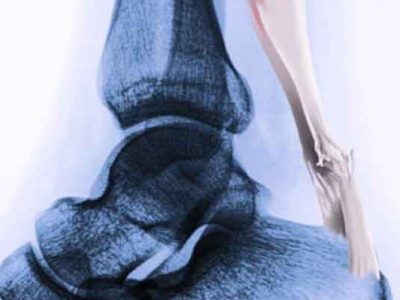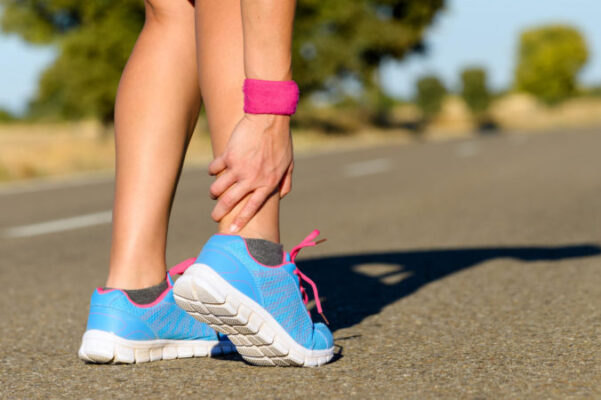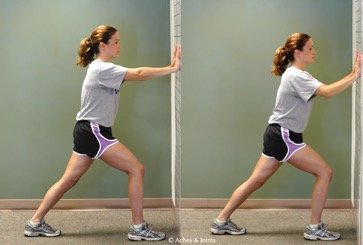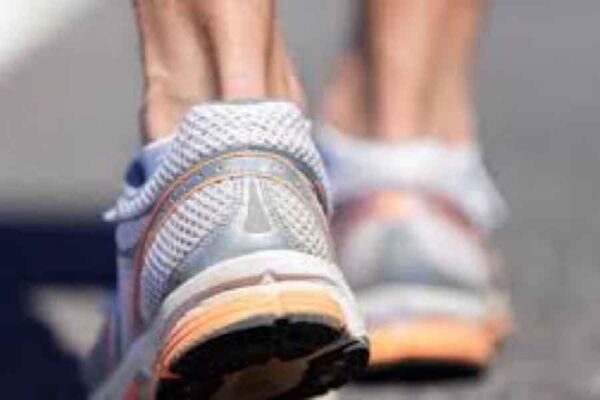Achilles tendon rupture
This is one of the most common tendon injuries that occurs in sport.
The rupture can be partial or total. The tendons show some signs of degenerative changes and weakness after the age of 30 and so rupture is most common in the 30-50 age group. Rupture may happen after resuming sport after a prolonged spell away.
What are the symptoms?
The most common initial symptom of Achilles tendon rupture is a sudden snap at the lower calf, intense pain and inability to point the foot downward. The patient may describe the noise like a gunshot going off.
The tendon may be more liable to tear if there has been previous inflammation, or after steroid injections around the tendon area or even steroids by mouth and certain antibiotics such as ciprofloxacin.
Immediately after injury there will be intense pain and possibly some bruising and swelling in the lower calf/ ankle area.
Walking will become difficult and the person will not be able to stand on tiptoes.
Often a gap in the tendon will be felt by hand.
The best test to see if there is a total rupture is the Simmonds/Thompson’s Test.
How to conduct the Simmonds/Thompson’s Test
The injured person lies on their tummy with the feet hanging over the edge of the treatment couch. The person testing then bends the knee slightly and squeezes the calf of the affected leg. If there is no movement of the foot, then there is a total tear. In the absence of a tear then the foot will move downwards on this test.
see video below


Function of Achilles tendon
The Achilles tendon consists of a band of fibrous tissue flexible but inelastic which attaches the calf muscles to the heel bone. It is formed from two muscles in the back of the calf, the gastrocnemius and the soleus, approx. 15 cm to 6 inches in length arising above the ankle joint and spirals as it crosses the ankle joint it attaches to the heel bone (calcaneus). A sheath surrounds the tendon, allowing it to glide easily as the ankle moves through its range of motion.
Since the calf muscles originate above the knee and the Achilles tendon attaches below the ankle, the function of the muscle-tendon unit is critical for walking and running. When the calf muscles contract, it causes the ankle to point the foot downward and the foot to turn inward and up).
The tendon needs to be strong. Running and climbing stairs generates force inside the tendon equal to 10 times the body’s weight.
Other causes of pain in the tendon
There are other causes of pain at the back of the heel than Achilles tendon rupture. It may be due to retrocalcaneal bursitis where inflammation occurs within the sac that cushions the tendon as it passes the bony edge of the heel bone. Achilles parateninopathy is inflammation of the tendon sheath that surrounds the length of the tendon. The treatment for bursitis and tendinopathy incorporates rest, exercise, and physiotherapy.
About 1 million people mainly athletes a year develop Achilles tendon inflammation or rupture. Achilles tendon rupture tends to occur more often in men than women in fact 6 times as many men than women sustain this injury. This may be due to the relative size of the calf to the tendon and women’s calf muscles may not be strong enough to cause a tear of this nature.
What causes an Achilles tendon rupture?
Previously injured/ torn Achilles tendon increases the risk for rupture. If you sustain a complete rupture on one leg there is a high chance of the same thing happening on the other leg as often it is caused by a very strong calf and a fine tendon.
Most commonly the Achilles ruptures when there is a sudden forceful movement of the foot downward against resistance. This often occurs in sorts like tennis and football.
Sometimes the tendon does not fully rupture but sustains a partial tear. The symptoms are similar to a full tear and a partial tear can progress to a full tear.
Underlying illness or disease may increase the risk of Achilles tendon injury. Examples include the following:
- Diabetes
- Thyroid disease
- Kidney failure
- Rheumatoid disease
- Gout
Some other risk factors for Achilles tendon injury also include the following:
- Older age
- Activities or sports that involve running and jumping
- Lack of flexibility
- Excessive activity (overuse)
- Sudden changes in intensity of exercise
- Poor conditioning
- Steroid use (either by mouth or by injection)
- Fluoroquinolone antibiotics
- Poorly fitting shoes
- Jogging or running on hard surfaces
- Hill climbing or stair walking
- Previous Achilles tendon injury
- Family history
Tests for confirming Diagnosis
Simmonds/Thompson’s Test as described above.
Imaging may be required to confirm the extent of tendon damage and to look for other associated injuries
Plain X-rays of the foot may reveal swelling of the soft tissues around the ankle, other bone injury, or tendon calcification.
Ultrasound is the next most commonly ordered test to document the injury and size of the tear. For a partial tear of the Achilles tendon, the diagnosis is not always obvious on a physical examination and an ultrasound may be considered.
MRI: Sometimes an MRI is ordered when a diagnosis of tendon rupture is not obvious on ultrasound or a complex injury is suspected. MRI is an excellent imaging test to assess for presence of any soft-tissue trauma or fluid collection. More importantly, MRI can help detect presence of tendon thickening, bursitis, and partial tendon rupture.
Partial Tendon rupture
Typical symptoms are pain at the time of injury which may get worse after you have stopped the activity. Pain will increase again when you resume activity. These may go after a warm up and then reappear more intensely after training. At this stage it is possible to enter a vicious cycle of pain which becomes hard to treat.
Morning stiffness may become a feature and sometimes a defect in the tendon can be felt.
Treatment should be rest and Ice in the acute phase.
Use of crutches if the pain is severe
Putting in a heel wedge in the affected shoe to take the pressure off the Achilles.
The doctor may prescribe a boot for 4-6 weeks
Treatment options for a full Achilles tendon rupture
Two options exist for Achilles tendon rupture, one involving surgical repair and the other a conservative treatment (allowing the tendon to heal on its own in a boot. Each has its benefits and risk and decisions will depend upon the patient’s clinical situation, underlying medical background, the extent of the injury, age and the expectation of future activity.
Surgical intervention
Surgery is the recommended treatment for the young, healthy and active individuals. For athletes, surgery is often the first choice of treatment. The Achilles tendon can be repaired surgically by either a percutaneous or open technique. With the open technique, the surgeon makes an incision to allow for better visualization and approximation of the tendon. With the percutaneous technique, the surgeon makes several small skin incisions to repair the tendon. Irrespective of type of treatment, you will be fitted with a postoperative boot on the operated ankle after completion of the procedure. Each approach has its benefits and risks and the choice of surgery type is tailored for each specific patient.
The advantages of a surgical approach includes a decreased risk of re-rupture rate (0%-5%); the majority of individuals can return to their original sporting activities (within a short time), and most regain their strength and endurance.
Disadvantages of a surgical approach include cost, the need for hospitalization and wound complications (for example, skin sloughing, infection, sinus tract formation, nerve injury
Nonsurgical treatment
Nonsurgical method may be recommended for patients who are older, less active, and have a higher risk for surgery and anaesthetic. Ability to heal wounds is also an important consideration and may include those with poor blood supply to their feet. These include patients with peripheral artery disease and diabetes
Nonsurgical management involves wearing a boot on the injured leg, with the foot in a slightly downward flexed position. Maintaining the ankle in this position helps bring the ruptured tendon ends closer together to allow them to heal. The leg is kept in the boot for 6-10 weeks and no movement of the ankle is allowed. Walking is allowed in the boot after a period of four to six weeks. When the boot is removed, a small heel lift is inserted in the shoe to decrease the stress on the Achilles tendon for an additional two to four weeks. Following this, physiotherapy is recommended.
The disadvantages of the nonsurgical approach includes an increased risk of re-rupture (up to 40%), prolonged immobilisation in a cast, and increased technical difficulty should subsequent surgery be required.
The benefits include no need for anaesthesia or hospitalization.
What are possible complications of an Achilles tendon rupture?
The complications of Achilles tendon rupture include tendon scarring and decreased range of motion, as well as muscle weakness.
Tendon re-rupture is a significant concern and can occur in up to 5% of surgically repaired patients and in some studies, up to 40% in conservatively treated patients.
After surgery, the patient is kept in a boot for four to six weeks, This is followed by physiotherapy and assisted range of motion exercises. A heel lift will be put in the shoe to prevent the excessive stretching of the tendon. Return to normal function is expected in four to six months.
With conservative treatment, the amount of movement can be altered every few weeks, with the foot being placed in less plantar flexion ( ie less foot pointed down) each time. This will occur for six to 12 weeks. After this period is complete and the tendon healed, physiotherapy will continue to return range of motion and power. A shoe heel lift will be considered.

Physiotherapy and Exercise after tendon rupture
For patients with partial rupture who are managed conservatively, rehabilitation should be started once the pain has diminished. Patients who undergo surgical repair of the Achilles tendon do not need physiotherapy during the acute phase of healing, but it is highly recommended once the incision has healed.
Physiotherapy is an important part of the post op recovery for the patient. After the boot is removed, the ankle is gently massaged and mobilized to reduce stiffness. After two weeks, active exercises are undertaken. A total of 12-16 weeks of active physiotherapy is required for the best results.
The aim of physiotherapy is to return range of motion of the ankle joint and regain the calf muscle length and strength to normal. The physiotherapist will give you a tailor- made exercise programme for each patient, sport/activity specific.
Prevention of Injury to the Achilles tendon:
- Flexibility of the lower leg and calf by regular stretches.
- If you have calf or heel pain stop the activity you are doing and rest. If rest does not help and the pain recurs when the activity resumes, then seek medical advice.
- Try to wear good fitting shoes that are not too worn and are specific for the activity planned.
What is the prognosis of an Achilles tendon rupture?
When proper treatment and rehabilitation are undertaken, the prognosis is excellent. The majority of athletes can return to their previous exercise or sports. Those patients who undergo nonsurgical care have an increased risk of repeated rupture, due to scar tissue repair, however good management can provide a functional outcome for those not returning to a high level of sport.
Useful website for explanations diagnosis and protocols are
Footandankle@fortiusclinic.com

